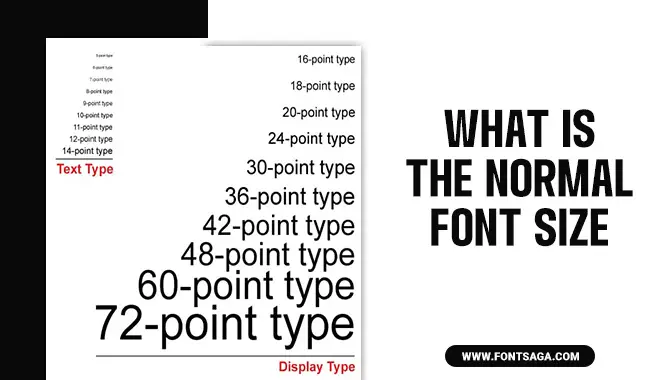In the digital era, it’s important to have a good understanding of what is the normal font size, typography, and font sizes. The text size can impact the readability and user experience of your website, document, or email.
Many people wonder about the normal font size and whether there are industry standards for font sizes. We’ll examine font sizes, what is normal, and why it matters for your design or content. First, we’ll explore the basics of font sizes and how they’re measured.
We’ll then delve into the different fonts and how they impact readability, including serif and sans-serif fonts. We’ll also discuss the importance of font hierarchy and how to use different font sizes to create a visual hierarchy that guides your reader’s eye.

What Is The Normal Font Size – You Should Know

In terms of font size, it is important to understand what is the normal font size. Generally, the default font size for most documents is 12 points, which is the standard size for most word processors. However, it is important to note that font sizes can vary depending on the medium in which they are being used.
Understanding Font Size
Understanding font size is an important aspect of creating any document or piece of writing. The font size refers to the size of the characters or letters used in the text. The normal font size typically used in most documents is 12 points.
This site is considered the most readable and comfortable for most people. However, the font size can vary depending on the document’s purpose. For example, if you are creating a poster or flyer, you should use a larger font size to make it easily visible from a distance.
Factors Influencing Font Size
Several factors influence the font size of a document. Firstly, the document’s purpose plays a significant role in determining the appropriate font size. For instance, a presentation slide for a large audience would require a larger font size than a document for personal use.
Additionally, the targeted audience is another determining factor. A font size suitable for an elderly audience would differ from a younger audience’s. The medium of presentation also plays a role, with font sizes for print media differing from those for online media.
Moreover, the desired visual impact of the document is also a crucial factor. A document with a bold and impactful message would require a larger font size to make an impact.
Common Font Sizes In Various Mediums
Regarding font size, the standard or normal size can vary depending on the medium used. In printed materials such as newspapers, the font size typically ranges from 8 to 14 points, with 10-12 points being the most common. In books, the font size usually ranges from 10 to 12 points.
However, the font size may be larger for large format books like coffee table books, typically around 14 to 18 points. In digital media, the font size can also vary depending on the device used.
Digital Media
Digital media has revolutionized the way we access and consume information. With a plethora of devices and platforms available, it has become easier than ever before to stay connected and informed. However, one question that often arises regarding digital media is the normal font size.
In the digital world, the font size is typically measured in pixels rather than points. The standard font size for most digital content is between 10 and 14 pixels. This is because the screen size can vary greatly between devices, and a font size that is too small or too large can lead to readability issues.
Presentations And Slideshows
When it comes to creating presentations and slideshows, one important factor to consider is the font size. The normal font size for presentations is typically between 28-36 points. However, this can vary depending on the presentation’s content and the size of the screen or projector used.
Remember to make the font size easily readable by the audience but not so large as to become distracting. If the font size is too small, it can be difficult for the audience to read and understand the presented information. On the other hand, if the font size is too large, it can take up too much space on the slide and make it difficult to fit all the necessary information.
Email And Messaging

Regarding email and messaging, font size is an important aspect to consider. Generally, the standard font size for emails and messages is 12 points. However, it is important to note that some individuals may prefer a larger or smaller font size based on their preferences or visual impairments.
It is also important to ensure that the font used is easily readable and does not strain the eyes of the recipient. This is especially important in professional settings where clear communication is necessary. Additionally, a font style that is easy to read, such as Times New Roman, Arial, or Calibri, is recommended.
Conclusion:
Choosing the right font size is crucial in creating an effective and legible document. While there is no definitive answer to the “normal” font size, it is generally accepted that 12-point font is a good starting point for most documents. The ideal font size will depend on the specific context and purpose of the document.
When deciding on the appropriate font size, it is always important to consider the reader’s needs and preferences and the document’s intended use. Considering these factors, you can ensure that your document is visually appealing and easy to read. If you read the above outline properly, we hope you now understand what is the normal font size.
FAQ:
What Is The Recommended Font Size For Websites?
The recommended font size for websites is generally around 14 to 16 pixels. This size ensures readability and allows users to adjust the font size.
What Font Size Should Be Used In Presentations?
In presentations, it is advisable to use a larger font size for better visibility. Typically, a font size of 24 to 32 points is recommended for headings, while body text can range from 18 to 24.
What Is The Standard Font Size For Emails And Newsletters?
The standard font size for emails and newsletters is typically 12 to 14 points or 14 to 16 pixels. This ensures the text is easily readable in email clients and on various devices.
How Does Age Influence The Appropriate Font Size?
As people age, their visual acuity may decline, requiring larger font sizes for comfortable reading. Older adults should use slightly larger font sizes, such as 14 to 16 points or 16 to 18 pixels.
What Is The Significance Of Font Size For Legibility And Accessibility?
Font size plays a crucial role in legibility and accessibility. Larger font sizes enhance readability, especially for individuals with visual impairments or reading difficulties. It is important to choose a font size that accommodates diverse users.

David Egee, the visionary Founder of FontSaga, is renowned for his font expertise and mentorship in online communities. With over 12 years of formal font review experience and study of 400+ fonts, David blends reviews with educational content and scripting skills. Armed with a Bachelor’s Degree in Graphic Design and a Master’s in Typography and Type Design from California State University, David’s journey from freelance lettering artist to font Specialist and then the FontSaga’s inception reflects his commitment to typography excellence.
In the context of font reviews, David specializes in creative typography for logo design and lettering. He aims to provide a diverse range of content and resources to cater to a broad audience. His passion for typography shines through in every aspect of FontSaga, inspiring creativity and fostering a deeper appreciation for the art of lettering and calligraphy.

